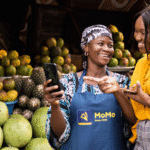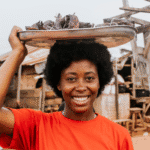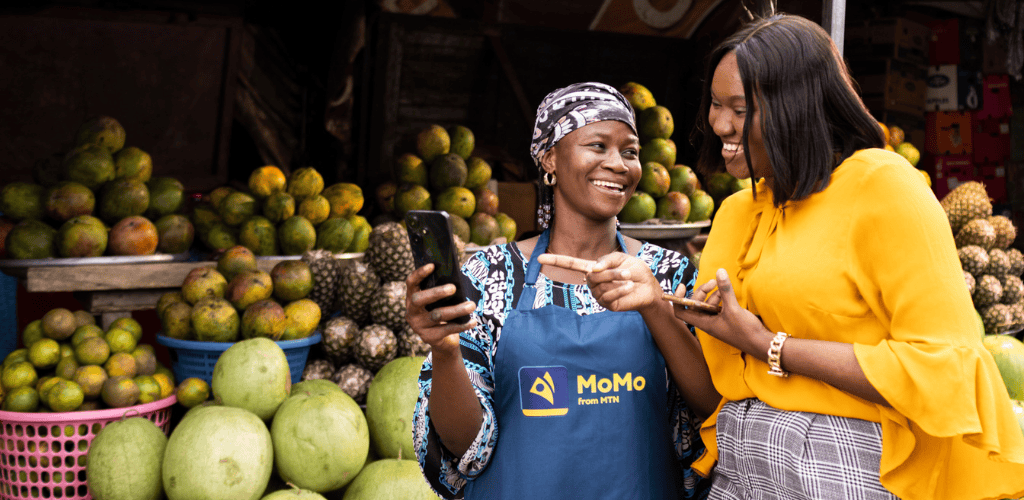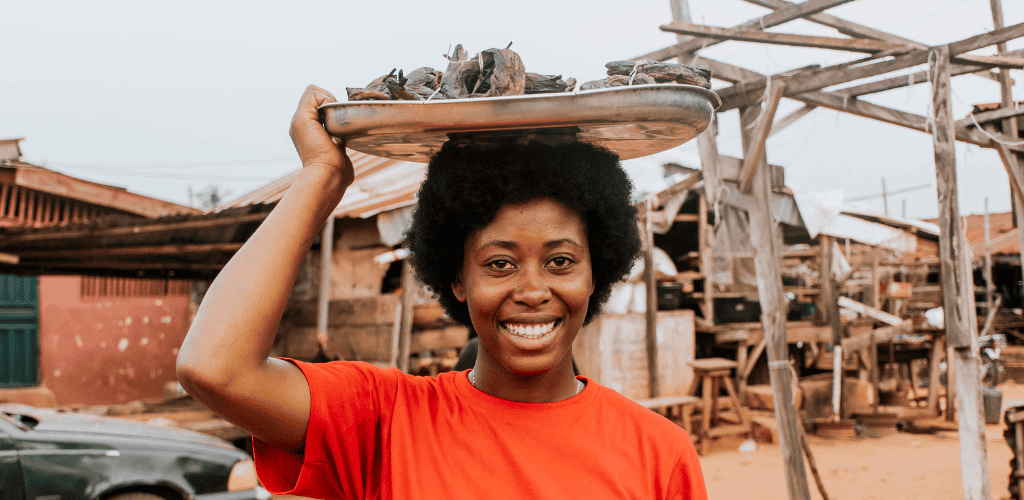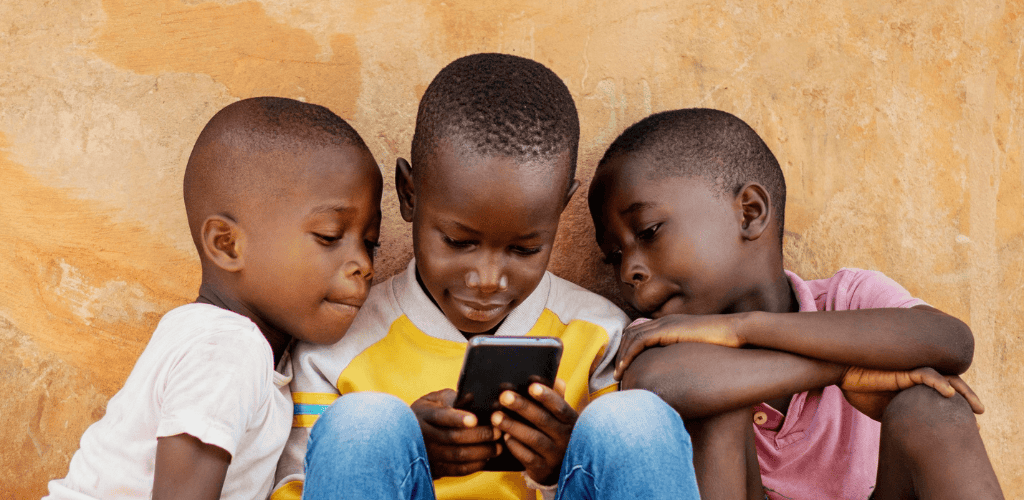Ghana has experienced significant economic and demographic changes over the years due to population growth and migration.
In this article, we round up population and demographic trends, providing key statistics and insights into how these factors affect the country’s development.
Key takeaways
- Muslims are projected to outnumber Christians in Ghana by 2096.
- The under-5 mortality rate in Ghana is over 40 deaths per 1,000 live births as of 2024.
- Ghana ranks 173rd globally in life expectancy in 2024, with an average life expectancy of 65.7 years.
- Ghana’s median age in 2024 is 21.1 years, reflecting a predominantly youthful population.
- In 2023, 59% of Ghana’s population lived in urban areas, with an annual urban growth rate of 3%
- Ghana’s population reached 34,121,985 in 2023, a 23.96% increase from a decade earlier.
- Ghana has more females than males as of 2023, with 17,105,457 females and 17,016,528 males.
General population statistics
1. Ghana’s population as of 2023 was 34,121,985. (World Bank)
According to the World Bank, Ghana’s total population reached 34,121,985 in 2023, an increase of approximately 23.96 from 27,525,597 a decade earlier.
2. Ghana has more females than males as of 2023. (World Bank)
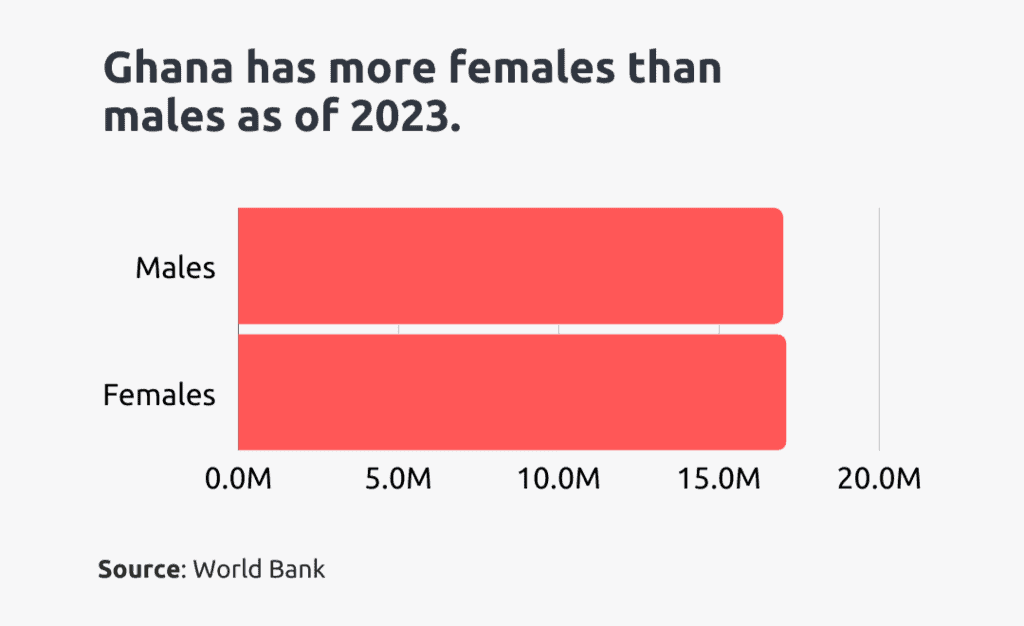 According to the World Bank, there were more females than males in Ghana, with a male population of 17,016,528 and a female population of 17,105,457 as of 2023.
According to the World Bank, there were more females than males in Ghana, with a male population of 17,016,528 and a female population of 17,105,457 as of 2023.
3. Ghana’s population of 65 and above was 1,245,271 as of 2023. (World Bank)
Ghana’s population of individuals aged 65 and above reached 1,245,271 in 2023, consisting of 558,340 males and 686,932 females.
4. Ghana’s urban population was 20,213,181 as of 2023. (World Bank)
According to the World Bank, Ghana’s urban population was 20,213,181 in 2023. This represents 59% of the total population, with an annual growth rate of approximately 3%.
5. Net migration in Ghana was -9,999 as of 2023. (World Bank)
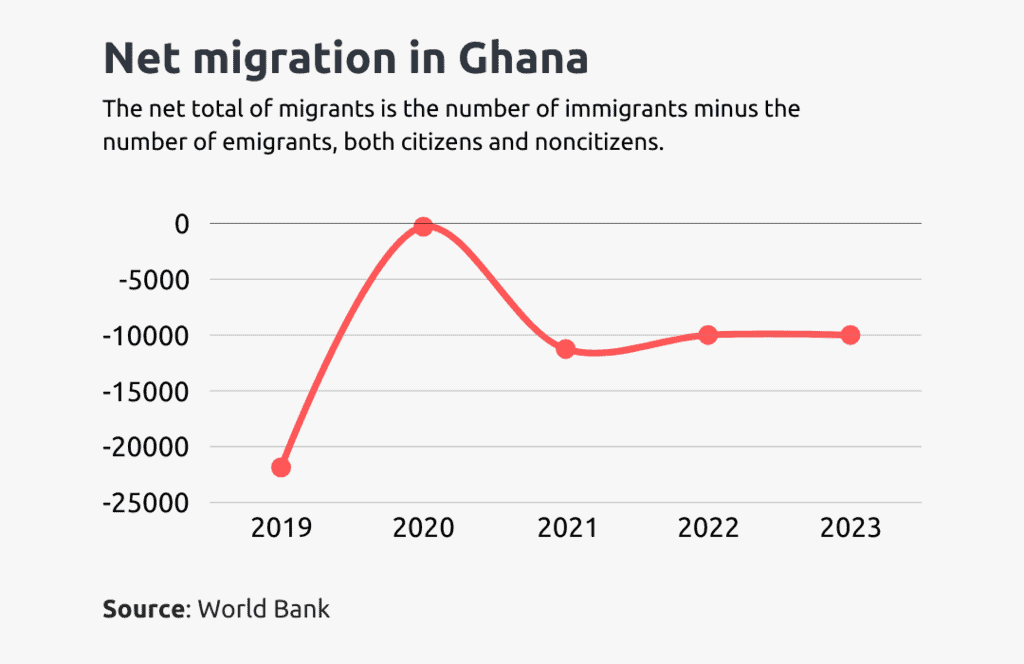 The net total of migrants is the number of immigrants minus the number of emigrants, both citizens and noncitizens. As of 2023, the net migration in Ghana was recorded at -9,999, meaning nearly 10,000 more people left the country than entered that year.
The net total of migrants is the number of immigrants minus the number of emigrants, both citizens and noncitizens. As of 2023, the net migration in Ghana was recorded at -9,999, meaning nearly 10,000 more people left the country than entered that year.
6. The total land area is 227,540 square kilometres. (Worldometers)
Ghana’s total land area, excluding areas under water bodies, national claims to the continental shelf, and exclusive economic zones, was reported to be 227,540 square kilometres (87,854 square miles) in 2024.
7. Median age in Ghana is 21.1 years in 2024. (Worldometers)
According to the United Nations, the median age in Ghana as of 2024 is 21.1 years, which indicates a youthful population.
8. The population growth rate in Ghana is 2.15% in 2024. (CIA, Macrotrends)
Ghana’s Population growth rate for 2024 is 2.15%, ranking the country 35th globally, up from 1.93% in 2023.
9. Ghana’s internet users increased in January 2024. (Data Reportal)
 As of January 2024, there were 24.06 million internet users in Ghana, with a significant portion of the population not using the internet.
As of January 2024, there were 24.06 million internet users in Ghana, with a significant portion of the population not using the internet.
10. As of 2024, the median age of females is higher than that of males. (CIA)
In 2024, the median age of females in Ghana was 22.3 years, higher than the male median of 20.6.
11. About 375,000 registered legal permanent residents are in Ghana. (WPR)
As of 2024, Ghana has approximately 375,000 registered legal permanent residents, including students and migrant workers.
12. Accra is the most populated city in Ghana as of 2024. (WPR)
Accra, the capital of Ghana, is the most populated city in the country, with a population of 1,963,264 as of 2024.
Ghana life expectancy
13. Life expectancy for both males and females is 65.7 years in 2024. (Worldometers)
As of 2024, the average life expectancy for both males and females in Ghana is 65.7 years.
14. Female life expectancy is higher than male life expectancy. (Worldometers)
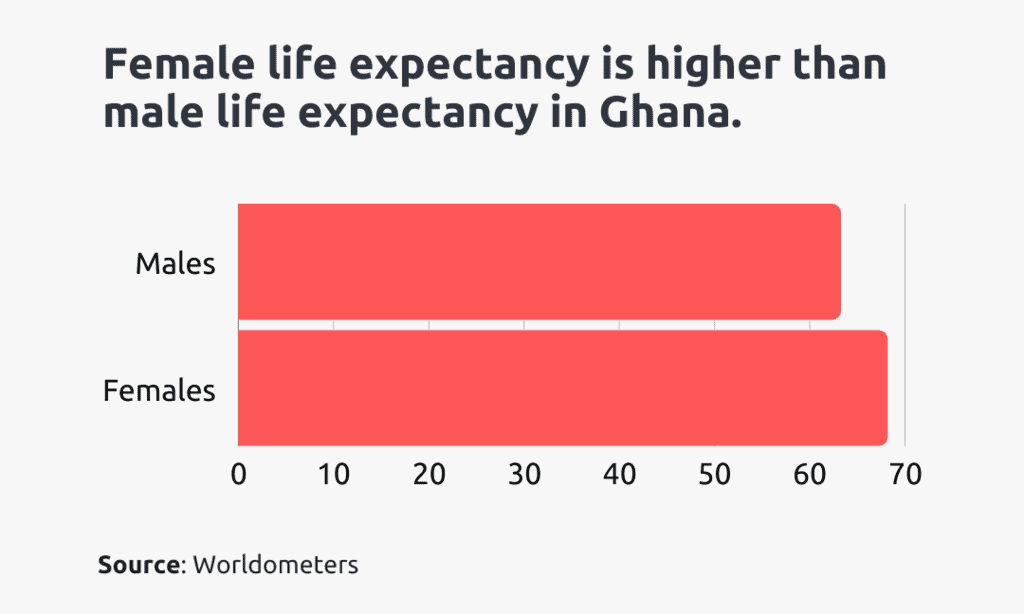 As of 2024, females are expected to live an average of 68.2 years in Ghana, while males are expected to live 63.3 years at birth.
As of 2024, females are expected to live an average of 68.2 years in Ghana, while males are expected to live 63.3 years at birth.
15. Ghana’s death rate is around 7 per 1,000 people as of 2024. (Macrotrends)
The number of deaths per 1,000 people in Ghana is 6.988% as of 2024.
16. Ghana’s birth rate is reported to be 27.5 in 2024. (Worldometers)
The number of births per 1,000 people in Ghana is 27.5 as of 2024.
17. Ghana ranks 173 in world ranking by life expectancy rates. (Worldometers)
Ghana is ranked 173rd in the world for life expectancy, with an average life expectancy rate of 65.70 years in 2024.
18. Over 2,400 babies are born in Ghana every day. (WPR)
 World Population Review reports that, on average, 2,443 babies are born each day in Ghana.
World Population Review reports that, on average, 2,443 babies are born each day in Ghana.
19. Approximately 660 people die in Ghana every day. (WPR)
Ghana records an average of 661 deaths per day.
20. Ghana’s life expectancy at birth increased 2022. (Statista)
Ghana’s life expectancy at birth increased from 63.8 in 2021 to 63.94 in 2022. Though a slight increase, it reflects improvements in healthcare and living conditions.
Infant mortality rate
21. The infant mortality rate reduced in Ghana in 2022. (Statista)
The infant mortality rate, the number of deaths per 1,000 live births, reduced from 32.5 in 2021 to 31.6 in 2022.
22. Ghana’s crude birth rate dropped slightly in 2022. (Statista)
The crude birth rate is the number of live births per year relative to the total population measured per 1,000 people. In 2022, the crude birth rate in Ghana reduced from 27.55 in 2021 to 27.08 in 2022.
23. Ghana’s fertility rate reached a historic low in 2022. (Statista)
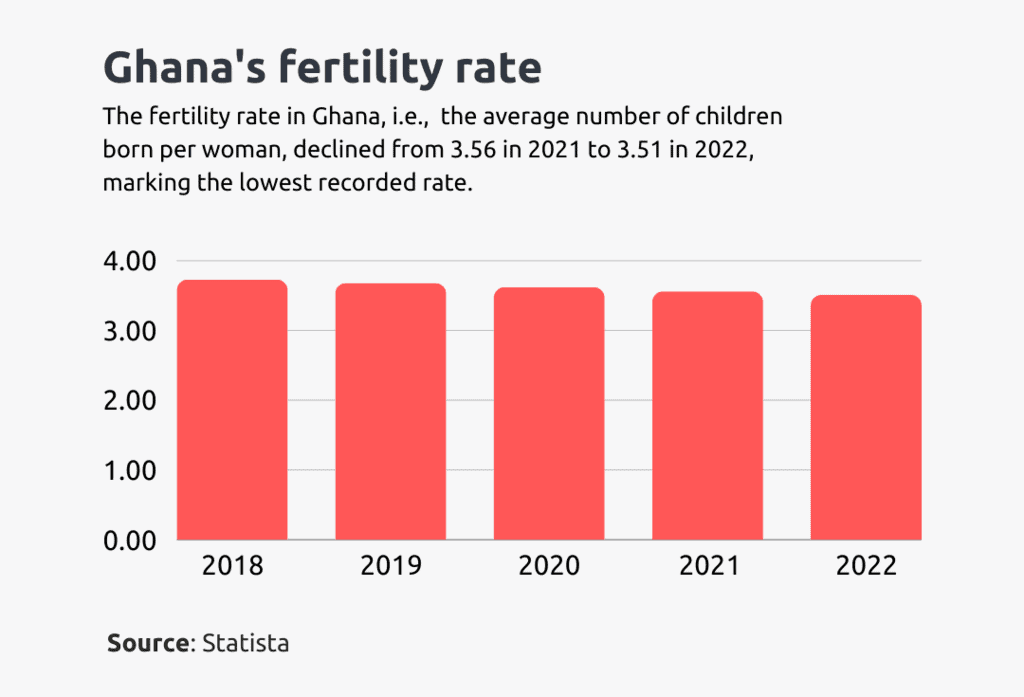 The fertility rate in Ghana, which reflects the average number of children born per woman, declined from 3.56 in 2021 to 3.51 in 2022, marking the lowest recorded rate in Ghana’s history.
The fertility rate in Ghana, which reflects the average number of children born per woman, declined from 3.56 in 2021 to 3.51 in 2022, marking the lowest recorded rate in Ghana’s history.
24. The infant mortality rate in Ghana stands at 30 as of 2024. (Worldometers)
The infant mortality rate in Ghana 30 deaths per 1,000 live births as of 2024.
25. The under-5 mortality rate in Ghana is just over 40 deaths per 1,000 live births as of 2024. (Worldometers)
The number of deaths of children under age 5 in Ghana stands at 40.1 per 1,000 live births as of 2024.
Ghana’s population by age
26. Ghana’s population remained youthful from 2022 to 2024. (Statista, CIA)
In 2022, Ghana’s population was largely youthful, with 36.94% aged 0 to 14, 59.51% aged 15 to 64, and 3.55% aged 65 and above. By 2024, the population structure had slightly shifted, with 37.4% aged 0 to 14, 58.2% aged 15 to 64, and 4.4% aged 65 and above.
27. The age dependency ratio in Ghana reached 67.37% in 2023. (Statista)
 The age dependency ratio, which measures the number of dependents per working-age population (15 to 64 years), stood at 67.37% in 2023, the lowest recorded ratio in Ghana.
The age dependency ratio, which measures the number of dependents per working-age population (15 to 64 years), stood at 67.37% in 2023, the lowest recorded ratio in Ghana.
28. There was an increase in the old age dependency ratio in Ghana in 2023. (Statista)
Ghana’s old age dependency ratio increased from 4.43% in 2022 to 6.11% in 2023, indicating an increase in elderly dependents.
Ghana ethnicity statistics
29. Akan is the largest ethnic group in Ghana as of 2024. (WPR)
Ghana’s Akan ethnic group accounts for 47.5% of the total population in 2024. The top seven largest ethnic groups include:
| Ethnic group | % of Population (2024) |
|---|---|
| Akan | 47.5% |
| Dagbani | 17% |
| Ewe | 14% |
| Ga-Adangbe | 7% |
| Gurma | 6% |
| Guan | 4% |
| Gurunsi | 2.5% |
30. Bissa is the least populated ethnic group in Ghana in 2024. (WPR)
Bissa, an ethnic group in Ghana, accounts for 1% of the total population in Ghana in 2024.
32. Asante Twi is Ghana’s most spoken language in 2024. (WPR)
In 2024, Asante Twi, spoken by 16% of the population, was Ghana’s most widely spoken language.
33. Ga is Ghana’s least-spoken language in 2024. (WPR)
In 2024, Ga is spoken by 3.1% of Ghana’s population, making it the least-spoken language.
34. Only about two-thirds of Ghana’s population speak English. (WPR, Seven Corners)
English is Ghana’s official language, and it is used in school and business settings. However, only 50% to 60% of the population speaks it fluently.
35. Over 80 languages were spoken in Ghana in 2023. (GVI)
In 2023, over 80 languages were spoken across Ghana, reflecting the diversity of its ethnic groups and tribes.
Ghana religion statistics
36. There were about 3509 churches in Ghana as of August 2024. (Smartscrapers)
As of August 15, 2024, 3,509 churches are in operation, and 3,453 churches out of the 3509, representing 98.40% of all the churches in Ghana, are owned by individuals.
37. Greater Accra region has the highest number of churches in Ghana. (Smartscrapers)
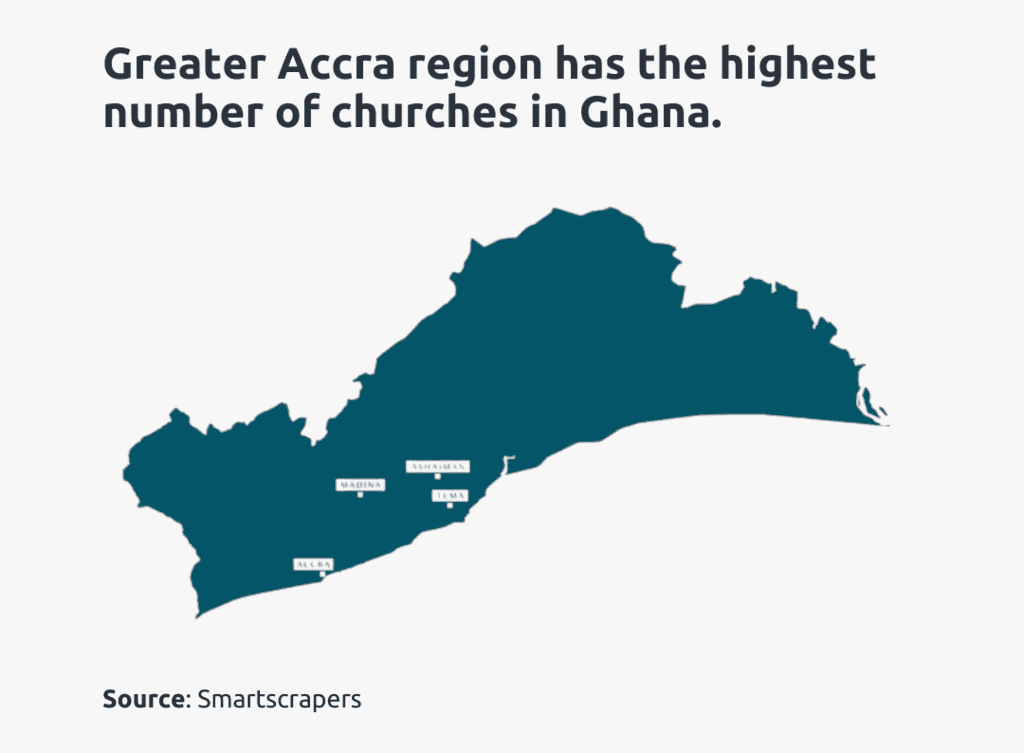
As of August 2024, the Greater Accra region had the highest number of churches in Ghana, with 2244 churches. The Ashanti region followed with 780 churches, and the Western region had 254 churches.
38. Few churches in Ghana have a social media presence. (Smartscrapers)
By August 2024, only about 360 churches had their website. Additionally, seven churches had LinkedIn profiles; 162 were active on Facebook, 78 on Instagram, 85 on X, 11 on TikTok, and 97 on YouTube channels.
39. Ghana scored 3 out of 4 in religious freedom in 2022. (Freedom House)
In 2022, Ghana scored 3 out of 4 for religious freedom and expression. This indicates that people were generally free to practise and express their religious faith or nonbelief, whether in public or private. However, in church-established schools, students of other religions are sometimes compelled to attend church services.
40. Muslims are predicted to outnumber Christians by 2096. (Noyam, Ghana Statistical Service)
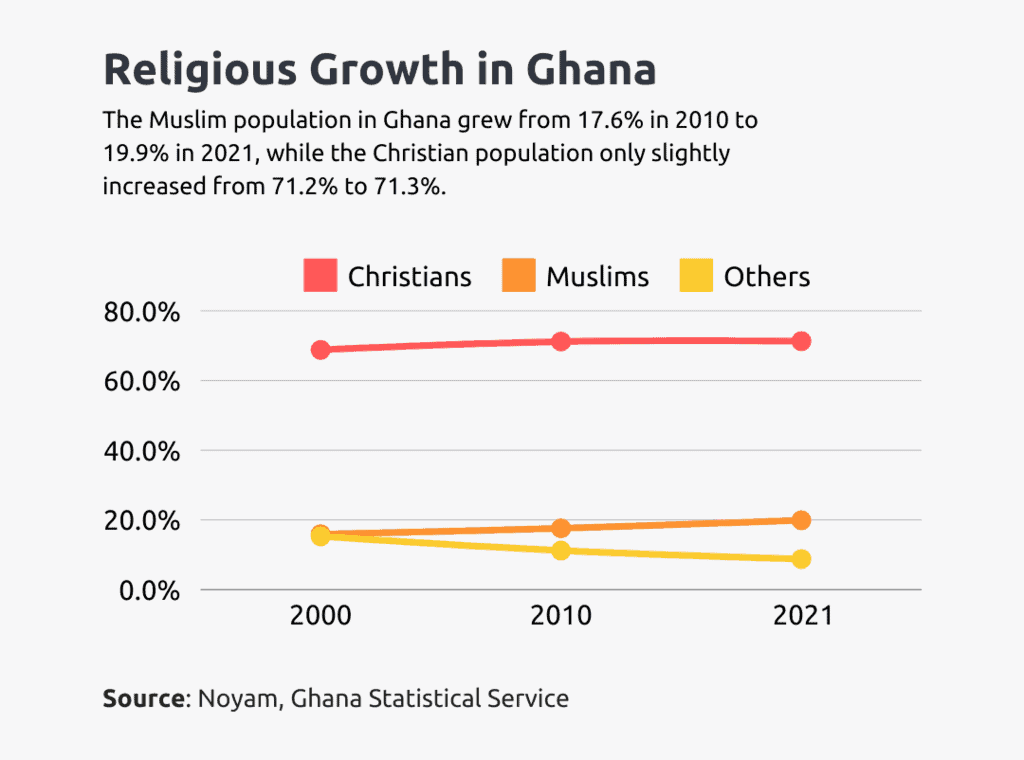
The Muslim population in Ghana grew from 17.6% in 2010 to 19.9% in 2021, while the Christian population only slightly increased from 71.2% to 71.3%. This trend, driven by higher fertility rates among Muslims, could lead to Muslims outnumbering Christians by the year 2096.
41. Christianity is the largest religion in Ghana. (Ghana Statistical Service)
As of 2021, Christianity remained the dominant religion in Ghana, accounting for 71.3% of the population. This included 17.4% Protestants, 10% Catholics, 31.6% Charismatic/Pentecostal, and 12.3% from other Christian denominations.
42. Ghana welcomes diverse religions. (Ghana Statistical Service)
Ghana is home to various religions. Aside from Christianity, Islam accounts for 19.9% of the population, traditional faiths account for 3.2%, 1.1% of people identify with no religion, and 4.5% follow other faiths.
Ghana diaspora statistics
43. In 2023, IOM helped 2,671 migrants travel safely across West and Central Africa. (IOM)
According to the International Organization for Migration (IOM) Ghana, in 2023, 1337 men and 1334 women migrants were aided to travel across both West and Central Africa safely.
44. In 2023, 1,702 refugees received help to relocate to 10 countries. (IOM)
In 2023, the IOM Ghana assisted 895 men and 807 women refugees from 16 countries in relocating to 10 countries in 2023.
45. In 2023, 174 victims of trafficking (VOTs) received assistance to return home in 2023. (IOM)
IOM Ghana provided support to 174 victims of trafficking (VOTs) in 2023, including two men and 172 women, to help them return to their home countries and participate in mentorship and training programs.
46. In 2023, 659 migrants received support in setting up microbusinesses in Ghana. (IOM)
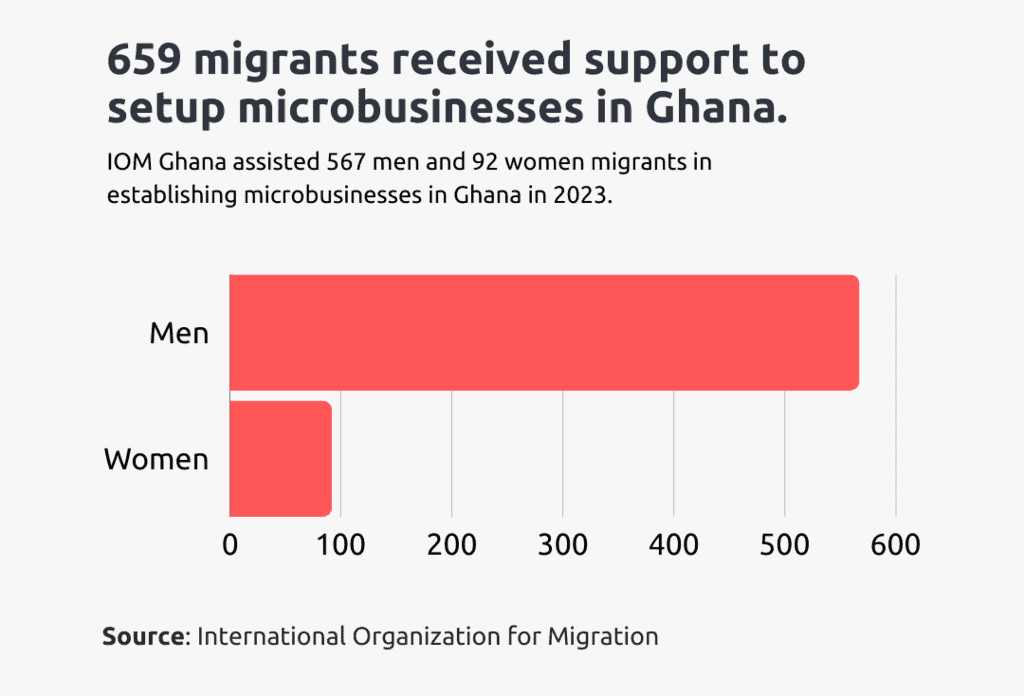
The IOM Ghana assisted 567 men and 92 women migrants in establishing microbusinesses in Ghana in 2023.
47. 835 migrants were helped with their return to Ghana in 2023. (IOM)
In 2023, IOM Ghana facilitated the return of 835 migrants, including 699 men and 136 women, from 32 countries.
48. In 2023, 647 migrants were assisted to return to Ghana from Libya. (IOM)
In 2023, 574 men and 73 women Ghanaians were assisted in returning to Ghana via three chartered flights from Libya.
49. 68,049 people accessed Canadian Visa Application Centre services in 2023. (IOM)
In 2023, 68,049 people used the services of the Canadian Visa Application Centre (CANVAC) to register their biometric details for visa applications.
50. 105 Ghanaian migrants returned to Ghana. (IOM)
IOM Ghana helped 66 men and 39 women Ghanaian migrants return home in 2023
51. Germany, the Netherlands, and Türkey were the countries where migrants returned to Ghana in 2023. (IOM)
In 2023, Germany, the Netherlands, and Türkey were the top countries from which Ghanaian migrants were assisted in returning home: Germany with 57 migrants (33 men, 24 women), the Netherlands with 12 migrants (nine men, three women), and Türkey with eight migrants (five men, three women).
52. 15 survivors of trafficking who are Ghanaians returned to Ghana in 2023. (IOM)
IOM Ghana assisted 15 survivors of trafficking, including 14 women and one man, to return to Ghana in 2023.
FAQs
What percentage of Ghana’s population is white?
3% of Ghana’s population is white.
Is Ghana underpopulated or overpopulated?
Ghana is neither underpopulated nor overpopulated, but it has a moderate population.
What is the population density of Ghana?
The population density of Ghana is 151 people per kilometre square in 2024.
Conclusion
Ghana can build a resilient and inclusive economy that benefits all its citizens and helps shape the nation’s future, leveraging its demographic advantages. Share your thoughts and questions with us in the comment section.

